Copyright Bernard Welchman 2021

About the Timber
A brief description of the timbers used
Click on an image to enlarge
Ash
Ash
is
a
good
strong
wood
with
a
straight
grain.
It
is
a
durable
and
has
various
uses
from
the
production
of
sports
equipment
to
cabinet
making.
The
timber
is
nice
to
work
with
and
usually
a
really
good
finish
can
be
achieved.
It
is
light
in
colour
and
can
have
a
lovely
orangish
grain.
It
is
also
often
stained
to
give
the
appearance
a
darker
wood.
Due
to
its
considerable
strength
Ash
has
had
a
number
of
uses
throughout
the
ages
ranging
from
making
bows
and
shafts
for
spears.
Today
it
is
used
mostly
for
interior
work
such
as
doors,
staircases,
architraves,
skirting
and
the
like.
It
is
particularly
good
for
bespoke
kitchens
and
makes
wonderful
flooring.
Its
only
drawback is Ash doesn’t have a natural durability for use outside and so needs to be treated beforehand.
Those
of
a
certain
age
or
have
an
interest
in
classic
cars,
will
know
that
it
was
used
as
the
distinctive
exterior
wood
on
the
Morris
Minor Traveller from 1953
Black Walnut
It
would
be
hard
to
overstate
Black
Walnut’s
popularity
among
woodworkers.
Its
working
characteristics
coupled
with
its
rich
brown
coloration
puts
the
wood
in
a
class
by
itself.
The
heartwood
can
range
from
a
lighter
pale
brown
to
a
dark
chocolate
brown
with
darker
brown
streaks.
The
sapwood
is
pale
yellow-grey
to
nearly
white.
The
grain
is
usually
straight
but
can
be
irregular
with
some
nice
patterns formed and occasionally spalted.
Black
Walnut
is
normally
easy
to
work
provided
the
grain
is
straight
and
regular.
It
machines
well
and
also
finishes
well.
It
has
a
number of uses including furniture, cabinetry, gunstocks, interior panelling and turned items to name a few.

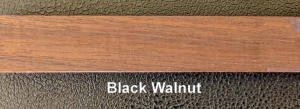
Brazilian Mahogany
Mahogany
has
a
straight,
fine,
and
even
grain,
and
is
relatively
free
of
voids
and
pockets.
Its
reddish-brown
colour
darkens
over
time
and
displays
a
reddish
sheen
when
polished.
It
has
excellent
workability
and
is
very
durable.
Historically,
the
tree's
girth
allowed
for
wide boards from traditional mahogany species. These properties make it a favourable wood for crafting cabinets and furniture.
Mahogany
is
still
widely
used
for
fine
furniture;
however,
the
rarity
of
Cuban
mahogany,
the
over-harvesting
of
Honduras
and
Brazilian
mahogany,
and
the
protests
by
indigenous
peoples
and
environmental
organizations
from
the
1980s
into
the
2000s,
have
diminished
their
use.
Recent
mahogany
production
from
Mexico
and
Fiji
has
a
lighter
colour
and
density
than
South
American
production
from
the
early 20th century.
This
particular
piece
of
Mahogany
that
these
pen
blanks
are
taekn
from
was
originally
bought
to
make
a
clock
with,
in
the
1970s,
but
was never used and has been stored in my shed ever since.
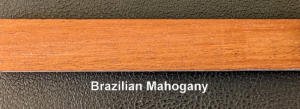
Brown Oak
Brown
Oak
is
technically
not
a
distinct
species
of
oak,
but
rather
refers
to
oak,
usually
English
Oak,
that
has
been
infected
with
a
fungus.
This
fungus
has
the
effect
of
turning
the
wood
a
deep
brown
colour.
Once
the
wood
has
been
cut
and
dried,
the
fungus
dies,
leaving a rich golden brown timber.
Oak
is
probably
one
of
the
most
well
known
deciduous
timbers.
There
are
said
to
be
over
500
different
knowns
varieties
of
this
tree
and
is
known
for
its
strength
and
was
extensively
used
in
ship
building
from
at
least
the
Viking
era.
It
was
also
used
in
the
making
of
good
quality
furniture,
barrels
and
numerous
other
items.
A
lot
of
people
do
not
like
using
oak
as
the
grain
can
be
very
course,
difficult
to
work
and
get
a
glass
like
finish.
However,
I
feel
that
most
people
buy
a
wooden
pen
for
it
to
feel
like
a
wooden
pen
and
not
a piece of plastic. Most of the oak that I use is English, but it is not always easy to tell particularly that sourced from old furniture.
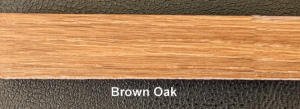
Cedar
There
are
many
species
of
Cedar,
probably
the
best
known
is
Western
Red
Cedar.
The
heartwood
reddish
to
pinkish
brown,
often
with
random
streaks
and
bands
of
darker
red/brown
areas.
It
has
narrow
sapwood,
which
is
pale
yellowish
white,
and
isn’t
always
sharply
defined
from
the
heartwood.
Has
a
straight
grain
and
a
medium
to
coarse
texture.
It
is
easy
to
work
with
both
hand
or
machine
tools,
though
it
dents
and
scratches
very
easily
due
to
its
softness
it
also
finishes
well.
All
of
my
pens
are
finshed
with
a
tough
finish
that
will
resist all but the harsh of handling
Its uses include shed making, boatbuilding, boxes, crates, and musical instruments.

Cypress
There
are
many
species
of
Cypress
which
are
deciduous
conifers
and
most
have
short
needles
with
a
feathery
appearance.
The
trees
have
a
straight
trunk
that
tapers
at
the
base,
giving
it
a
soaring
perspective.
In
cultivated
landscapes,
they
grow
50
to
80
feet
(15-24
m.) tall. It is a light timber that works well and has a nice finish.
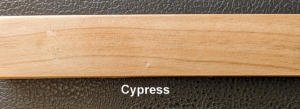
English Cherry
Cherry
is
one
of
the
few
fruit
woods
commercially
used
in
the
UK
for
both
furniture
and
joinery.
The
natural,
warm
lustre
and
attractive
grain
of
English
cherry
set
it
apart
as
one
of
the
most
luxurious
species
from
our
native
forests.
The
sap
wood
of
cherry
is
a
creamy
white
colour
which
contrasts
with
the
light
pink
of
the
heart
wood.
English-grown
cherry
can
sometimes
develop
green
tints
and streaks which add interest.
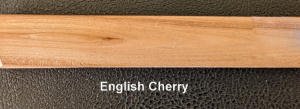
English Elm
Elm
is
a
hardwood
that
is
thought
to
have
been
introduced
to
England
during
the
Bronze
Age.
Is
a
hardwearing
timber
that
has
been
used
for
furniture
for
centuries
although
it
can
be
somewhat
difficult
to
work
sometimes.
It
has
a
greyish,
brown
colour
and
can
have
a really nice grain. Sadly, Dutch Elm Disease, has wiped out millions of trees and this has made it a rare tree to be seen now.
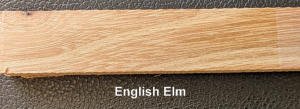


Copyright Bernard Welchman 2021
About the Timber
A brief description of the timbers used
Click on an image to enlarge
Ash
Ash
is
a
good
strong
wood
with
a
straight
grain.
It
is
a
durable
and
has
various
uses
from
the
production
of
sports
equipment
to
cabinet
making.
The
timber
is
nice
to
work
with
and
usually
a
really
good
finish
can
be
achieved.
It
is
light
in
colour
and
can
have
a
lovely
orangish
grain.
It
is
also
often
stained
to
give
the
appearance
a
darker
wood.
Due
to
its
considerable
strength
Ash
has
had
a
number
of
uses
throughout
the
ages
ranging
from
making
bows
and
shafts
for
spears.
Today
it
is
used
mostly
for
interior
work
such
as
doors,
staircases,
architraves,
skirting
and
the
like.
It
is
particularly
good
for
bespoke
kitchens
and
makes
wonderful
flooring.
Its
only
drawback
is
Ash
doesn’t
have
a
natural
durability
for
use
outside
and
so
needs
to
be treated beforehand.
Those
of
a
certain
age
or
have
an
interest
in
classic
cars,
will
know
that
it
was
used
as
the
distinctive
exterior
wood on the Morris Minor Traveller from 1953
Black Walnut
It
would
be
hard
to
overstate
Black
Walnut’s
popularity
among
woodworkers.
Its
working
characteristics
coupled
with
its
rich
brown
coloration
puts
the
wood
in
a
class
by
itself.
The
heartwood
can
range
from
a
lighter
pale
brown
to
a
dark
chocolate
brown
with
darker
brown
streaks.
The
sapwood
is
pale
yellow-grey
to
nearly
white.
The
grain
is
usually
straight
but
can
be
irregular
with
some
nice
patterns
formed and occasionally spalted.
Black
Walnut
is
normally
easy
to
work
provided
the
grain
is
straight
and
regular.
It
machines
well
and
also
finishes
well.
It
has
a
number
of
uses
including
furniture,
cabinetry,
gunstocks,
interior
panelling
and
turned
items
to
name
a
few.


Brazilian Mahogany
Mahogany
has
a
straight,
fine,
and
even
grain,
and
is
relatively
free
of
voids
and
pockets.
Its
reddish-brown
colour
darkens
over
time
and
displays
a
reddish
sheen
when
polished.
It
has
excellent
workability
and
is
very
durable.
Historically,
the
tree's
girth
allowed
for
wide
boards
from
traditional
mahogany
species.
These
properties
make
it
a
favourable
wood
for
crafting
cabinets
and furniture.
Mahogany
is
still
widely
used
for
fine
furniture;
however,
the
rarity
of
Cuban
mahogany,
the
over-harvesting
of
Honduras
and
Brazilian
mahogany,
and
the
protests
by
indigenous
peoples
and
environmental
organizations
from
the
1980s
into
the
2000s,
have
diminished
their
use.
Recent
mahogany
production
from
Mexico
and
Fiji
has
a
lighter
colour
and
density
than
South
American
production
from the early 20th century.
This
particular
piece
of
Mahogany
that
these
pen
blanks
are
taekn
from
was
originally
bought
to
make
a
clock
with,
in
the
1970s,
but
was
never
used
and
has
been
stored
in
my
shed ever since.

Brown Oak
Brown
Oak
is
technically
not
a
distinct
species
of
oak,
but
rather
refers
to
oak,
usually
English
Oak,
that
has
been
infected
with
a
fungus.
This
fungus
has
the
effect
of
turning
the
wood
a
deep
brown
colour.
Once
the
wood
has
been
cut
and
dried,
the
fungus
dies,
leaving
a
rich
golden
brown timber.
Oak
is
probably
one
of
the
most
well
known
deciduous
timbers.
There
are
said
to
be
over
500
different
knowns
varieties
of
this
tree
and
is
known
for
its
strength
and
was
extensively
used
in
ship
building
from
at
least
the
Viking
era.
It
was
also
used
in
the
making
of
good
quality
furniture,
barrels
and
numerous
other
items.
A
lot
of
people
do
not
like
using
oak
as
the
grain
can
be
very
course,
difficult
to
work
and
get
a
glass
like
finish.
However,
I
feel
that
most
people
buy
a
wooden
pen
for
it
to
feel
like
a
wooden
pen
and
not
a
piece
of
plastic.
Most
of
the
oak
that
I
use
is
English,
but
it
is
not
always
easy
to
tell
particularly
that sourced from old furniture.

Cedar
There
are
many
species
of
Cedar,
probably
the
best
known
is
Western
Red
Cedar.
The
heartwood
reddish
to
pinkish
brown,
often
with
random
streaks
and
bands
of
darker
red/brown
areas.
It
has
narrow
sapwood,
which
is
pale
yellowish
white,
and
isn’t
always
sharply
defined
from
the
heartwood.
Has
a
straight
grain
and
a
medium
to
coarse
texture.
It
is
easy
to
work
with
both
hand
or
machine
tools,
though
it
dents
and
scratches
very
easily
due
to
its
softness
it
also
finishes
well.
All
of
my
pens
are
finshed
with
a
tough
finish
that
will
resist
all
but
the
harsh of handling
Its
uses
include
shed
making,
boatbuilding,
boxes,
crates,
and musical instruments.

Cypress
There
are
many
species
of
Cypress
which
are
deciduous
conifers
and
most
have
short
needles
with
a
feathery
appearance.
The
trees
have
a
straight
trunk
that
tapers
at
the
base,
giving
it
a
soaring
perspective.
In
cultivated
landscapes,
they
grow
50
to
80
feet
(15-24
m.)
tall.
It
is
a
light timber that works well and has a nice finish.

English Cherry
Cherry
is
one
of
the
few
fruit
woods
commercially
used
in
the
UK
for
both
furniture
and
joinery.
The
natural,
warm
lustre
and
attractive
grain
of
English
cherry
set
it
apart
as
one
of
the
most
luxurious
species
from
our
native
forests.
The
sap
wood
of
cherry
is
a
creamy
white
colour
which
contrasts
with
the
light
pink
of
the
heart
wood.
English-
grown
cherry
can
sometimes
develop
green
tints
and
streaks
which add interest.

English Elm
Elm
is
a
hardwood
that
is
thought
to
have
been
introduced
to
England
during
the
Bronze
Age.
Is
a
hardwearing
timber
that
has
been
used
for
furniture
for
centuries
although
it
can
be
somewhat
difficult
to
work
sometimes.
It
has
a
greyish,
brown
colour
and
can
have
a
really
nice
grain.
Sadly,
Dutch
Elm
Disease,
has
wiped
out
millions
of
trees
and
this
has
made
it
a
rare
tree
to
be
seen now.








































